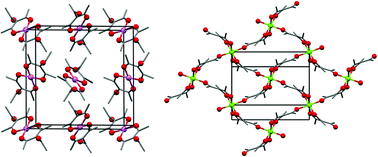The novel metal complexes bis(3-acetyl-2,4-pentanedionato-O2,O3)palladium(II), Pd[C7O3H9]2, and bis(3-acetyl-2,4-pentanedionato-O2,O3)magnesium(II), Mg[C7O3H9]2, have been synthesized. They are comprehensively characterized by a number of complementary methods. Spectroscopic data of the molecules in solution have been obtained by means of 1H- and 13C NMR. X-Ray powder diffractograms, IR- and micro-Raman spectra have been obtained from polycrystalline material and are discussed in detail. The crystal structures have been determined from laboratory X-ray powder diffraction data and subsequently refined with the Rietveld technique. In both complexes, the central metal cation is coordinated by two chelating ligands, forming a square-planar coordination. The crystal structure of the palladium(II) complex is comprised of isolated molecules the stability and catalytic capabilities of which make the compound a promising candidate as a metal–organic frameworks (MOF) interlinker. In contrast, the magnesium(II) complex undergoes supplementary intermolecular ligation to complete an octahedral coordination of the Mg(II), resulting in an extended layer structure. Line-shifts and -splittings in the Raman spectra are identified, from which the structural features of further complexes could be identified.

You have access to this article
 Please wait while we load your content...
Something went wrong. Try again?
Please wait while we load your content...
Something went wrong. Try again?


 Please wait while we load your content...
Please wait while we load your content...